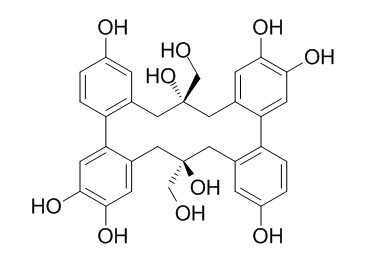Caesappanin C
Caesappanin C exhibits a proliferation stimulating activity against primary osteoblastic cells.
Inquire / Order:
manager@chemfaces.com
Technical Inquiries:
service@chemfaces.com
Tel:
+86-27-84237783
Fax:
+86-27-84254680
Address:
1 Building, No. 83, CheCheng Rd., Wuhan Economic and Technological Development Zone, Wuhan, Hubei 430056, PRC
Providing storage is as stated on the product vial and the vial is kept tightly sealed, the product can be stored for up to
24 months(2-8C).
Wherever possible, you should prepare and use solutions on the same day. However, if you need to make up stock solutions in advance, we recommend that you store the solution as aliquots in tightly sealed vials at -20C. Generally, these will be useable for up to two weeks. Before use, and prior to opening the vial we recommend that you allow your product to equilibrate to room temperature for at least 1 hour.
Need more advice on solubility, usage and handling? Please email to: service@chemfaces.com
The packaging of the product may have turned upside down during transportation, resulting in the natural compounds adhering to the neck or cap of the vial. take the vial out of its packaging and gently shake to let the compounds fall to the bottom of the vial. for liquid products, centrifuge at 200-500 RPM to gather the liquid at the bottom of the vial. try to avoid loss or contamination during handling.
The Japan Society for Analytical Chemistry2017, 613-617
Applied Biological Chemistry 2021, 64(75)
Antioxidants (Basel).2021, 10(1):112.
Molecules.2024, 29(3):671.
Oxid Med Cell Longev.2020, 2020:8887251.
Molecules.2020, 25(23):5609.
Antioxidants (Basel).2023, 12(12):2078.
Chemical Engineering Journal2024, 500:157110
J. Korean Wood Sci. Technol.2022, 50(5):338-352.
Foods.2022, 11(6):882.
Related and Featured Products
Plant Tissue Culture Letters, 2014, 31(5):505-509.
Phytochemical investigation of the active constituents from Caesalpinia sappan on stimulation of osteoblastic cells.[Reference:
WebLink]
Heartwood of Caesalpinia sappan L. has been traditionally used to many diseases such as homoptysis, syphilis, eye disease, dysentery, depurative and prevention of osteoporosis. Our previous in vitro screening of Indonesian plants revealed that an ethanolic extract of the heartwood of C. sappan exhibits a proliferation stimulating activity against primary osteoblastic cells.
METHODS AND RESULTS:
In our continued interest to this plant, we further fractionated the extract and isolated active constituents on the basis of the stimulating activity in the osteoblastic cells. The fractionation and isolation were carried out with various chromatography methods and the structure of isolated compounds was elucidated based on NMR, IR, UV and MS spectroscopic data. From an active fraction, a new biphenyl dimer, namely Caesappanin C (1), along with two known compounds, protosappanin A (2) and sappanchalcone (3), were isolated.
CONCLUSIONS:
Among them, the new compound 1 exhibited the strongest activity and significantly increased the cell viability up to 276 +/- 5%. The other two compounds 2 and 3 also stimulated the cell proliferation and increased the cell viability up to 233 +/- 8% and 187 +/- 4%, respectively.



